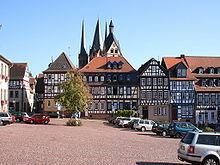Admin. region Darmstadt Elevation 180 - 312 m (−844 ft) Population 21,489 (30 Jun 2009) | Time zone CET/CEST (UTC+1/+2) Local time Saturday 3:28 PM | |
 | ||
Weather 13°C, Wind E at 14 km/h, 41% Humidity Points of interest Imperial Palace - G, Heimatmuseum, Nexus Exit | ||
Gelnhausen is a town and the capital of the Main-Kinzig-Kreis, in Hesse, Germany. It is located approximately 40 kilometers east of Frankfurt am Main, between the Vogelsberg mountains and the Spessart range at the river Kinzig. It is one of the eleven towns (urban municipalities) in the district. Gelnhausen has around 22,000 inhabitants.
Contents
- Map of 63571 Gelnhausen Germany
- Location
- History
- Attractions
- Town twinning
- Transport
- Notable people
- References
Map of 63571 Gelnhausen, Germany
Location
According to the Institut Géographique National from 1 January 2007 until July 2013 the geographic centre of the European Union was located on a wheat field outside the town.
Gelnhausen is located on the German Fairy Tale Route, a tourist route.
History
Gelnhausen was founded by Emperor Frederick Barbarossa in 1170, it is therefore nicknamed "Barbarossastadt". The place was chosen because it was at the intersection of the Via Regia imperial road between Frankfurt and Leipzig and several other major trade routes. Frederick had three villages connected by streets and surrounded by a wall. At the same time Gelnhausen received town privileges and a Kaiserpfalz was erected on an island of the Kinzig river. The emperor also granted trade privileges like the staple right which forced traveling merchants to offer their goods in the town for three days.
Hence Gelnhausen initially was a thriving trade town and head of a league of 16 towns of the Wetterau region. However prosperity came to an end already in 1326 when Emperor Louis IV gave the town in pawn to the counts of Hanau, redeemed shortly afterwards. In 1349 Count Günther von Schwarzburg received Gelnhausen from Emperor Charles IV for renouncing his claims as elected King of the Romans, in condominium with the counts of Hohnstein, who sold their share to Schwarzburg in 1431. Schwarzburg was acquired in 1435 by Elector Palatine Louis III and the Hanau, since raised to a county.
Repeated plundering in the Thirty Years' War as depicted by Hans Jakob Christoffel von Grimmelshausen in his novel Simplicius Simplicissimus made it nearly uninhabitable. In 1736, the extinction of the comital line of Hanau meant the condominium share was inherited by the Landgraviate of Hesse-Kassel, who acquired the Palatinate's share ten years later.
The varying lords made continued attempts to challenge Gelnhausen's imperial immediacy, it however formally remained a Reichsstadt. During the German Mediatisation of 1803 the city became a part of the Landgraviate of Hesse-Kassel, which was raised to an electorate and, after the Austro-Prussian War of 1866, was annexed by Prussia. At this time Gelnhausen had completely recovered and with the Gründerzeit economic boom became a centre of the German rubber industry.
From the 1930s Gelnhausen was a garrison town of the German Wehrmacht and, after World War II, of the United States Army. The US Army closed Coleman Kaserne in 2007.
In 1996, the town hosted the 36th Hessentag state festival.
Attractions
Sights include:
Town twinning
Gelnhausen is twinned with:
Transport
Gelnhausen lies directly on the German autobahn A66. Gelnhausen station is located on the Kinzig Valley Railway, a major line between Frankfurt and Fulda. Regional services from Frankfurt to Fulda or Wächtersbach stop in Gelnhausen.
Notable people
Like many American soldiers, in 1959 Colin Powell, then lieutenant of the 3rd Armored Division, served at Coleman Kaserne. A street was later named after him. During the Second Gulf War there was some discussion about renaming the street because of Germany's stance on the war. The mayor of Gelnhausen strongly objected.
